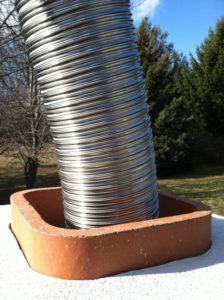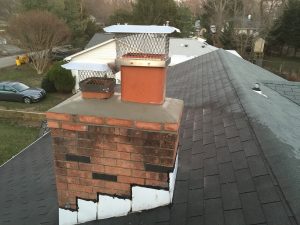Have you been told you need a chimney liner, or that your current chimney flue liner needs to be replaced? Before making a chimney repair decision that impacts your home and budget, it is important to understand what a chimney liner is and how chimney liners work. Understanding what the facts will provide you with the knowledge that you need to make the best decision concerning your chimney liner repairs.
What Is A Chimney Flue Liner?
The chimney flue is the passageway in your chimney that smoke and other gasses travel to escape your house safely. A chimney liner is the tube inside the chimney flue that guides the smoke and gasses out of your house, protecting the masonry and other internal chimney parts. can also be called a chimney liner because that is its function: it lines your chimney so that it works safely and efficiently.

How Do Chimney Liners Work?
A chimney liner protects a masonry chimney by forming a barrier between the construction of the chimney and the hot, corrosive exhaust it carries to the outside. Government studies in the past have shown that without a liner, chimneys quickly become unsafe to use. Because of these studies, most building codes require a chimney to be lined for safety.
- Unlined chimneys are quickly degraded by the corrosion of mortar in contact with flue gasses and leak carbon monoxide into the home.
- In addition to dangerous carbon monoxide, missing mortar has caused fires by heating nearby woodwork to the point of combustion.
- Modern appliances need proper ventilation in order to work correctly. A liner in the right size adapts an older chimney so that it gives your new gas fireplace, for instance, the draft it needs for adequate combustion and the exhaust path it needs for safe operation.
What Kind of Chimney Liner Do I Need?
There are currently three types of chimney liner; cast-in-place, clay tile, and metal. Each type has its pros and cons. No matter which kind of liner your chimney has, it should be evaluated during the annual inspection and cleaned or repaired if necessary. If you have a new hearth appliance, it may need to be replaced.
Cast-In-Place Liners
As the name indicates, a cast-in-place chimney liner is installed by forming a mold inside your chimney and pouring a lightweight cement-like material into it. This material hardens into a seamless insulation for your chimney that has no cracks or snags for creosote to build on.
- Pros — This type of liner adds stability to older chimneys. It is a permanent structure that is suitable for all types of fuel;
- Cons — The process of building the mold and casting the liner in place is for expert professionals only. Because it requires this standard of installation, it is expensive.
Clay Tile Liners
Clay tiles are a common type of chimney liner that works well with an open fireplace when the chimney is in good condition. You may have seen them used as planters or outdoor landscape features because they are readily available.
- Pros — Clay tiles are inexpensive and can be found in most hardware or home improvement stores.
- Cons — Clay tiles will split during a chimney fire because the rapid change of temperature is too much for the clay to handle. A clay tile liner is also a poor choice for modern gas appliances because it will not contain the liquids in combustion produced by gas fuel.

Metal Liners
A metal liner is usually used to upgrade an existing chimney or repair it when the damage has affected its usability. These liners can be made of stainless steel or aluminum to form a sleeve that fits into your chimney’s flue. Stainless steel liners are suitable for wood, gas, and oil fuels but aluminum is only appropriate for certain gas applications.
- Pros — Metal chimney liners last a long time and are very safe when properly installed and insulated.
- Cons — Metal chimney liners cost much more than clay tile liners.

Common Chimney Liner Problems and Causes
No matter what kind of liner your chimney has, it needs to be inspected regularly and cleaned if necessary. This is because there can be problems that escalate into dangers for your home and family.
- The wrong size of liner for the fuel being used can result in a creosote buildup with wood stoves or carbon monoxide leaking back into the room. If you have changed fuels or appliances, make sure the flue liner is the correct size for the current conditions.
- The wrong type of metal for the current fuel will cause problems, too, because it will corrode due to the acidic nature of the gas being vented. Make sure the liner is appropriate for the fuel to avoid this issue.
- Clay tile liners can crack during violent temperature changes. Insulation helps with this because it moderates the rate of the temperature shift.
- Clay tiles that are not properly cemented together are vulnerable at their joints. As the mortar deteriorates, moisture and the freeze/thaw cycle make the problems worse.
- Moisture coming inside the chimney flue can eventually cause a problem with the liner. Chimney caps and screens keep moisture and other potentially damaging things out of the chimney.


